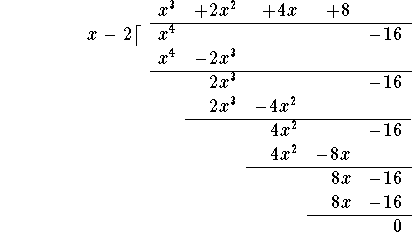 Factoring and Roots of Polynomials
Factoring and Roots of Polynomials Factoring and Roots of Polynomials
Factoring and Roots of Polynomials
If you write a polynomial as the product of two or more polynomials, you have factored the polynomial. Here is an example:
![]()
The polynomials x-3 and ![]() are called factors of the polynomial
are called factors of the polynomial ![]() . Note that the degrees of the factors, 1 and 2, respectively, add up to the degree 3 of the polynomial we started with. Thus factoring breaks up a complicated polynomial into easier, lower degree pieces.
. Note that the degrees of the factors, 1 and 2, respectively, add up to the degree 3 of the polynomial we started with. Thus factoring breaks up a complicated polynomial into easier, lower degree pieces.
We are not completely done; we can do better: we can factor
![]()
We have now factored the polynomial into three linear (=degree 1) polynomials. Linear polynomials are the easiest polynomials. We can't do any better. Whenever we cannot factor any further, we say we have factored the polynomial completely.
![]()
Once again consider the polynomial
![]()
Let's plug in x=3 into the polynomial.
![]()
Consequently x=3 is a root of the polynomial ![]() .
Note that (x-3) is a factor of
.
Note that (x-3) is a factor of ![]() .
.
Let's plug in ![]() into the polynomial:
into the polynomial:

Thus, ![]() is a root of the polynomial
is a root of the polynomial ![]() .
Note that
.
Note that ![]() is a factor of
is a factor of ![]() .
.
Since we have already factored
![]()
there is an easier way to check that x=3 and ![]() are roots of f(x), using the right-hand side:
are roots of f(x), using the right-hand side:

Does this work the other way round?
Let's look at an example: consider the polynomial ![]() . Note that x=2 is a root of f(x), since
. Note that x=2 is a root of f(x), since
![]()
Is (x-2) a factor of ![]() ? You bet!
We can check this by using long polynomial division:
? You bet!
We can check this by using long polynomial division:

So we can factor
![]()
Let's sum up: Finding a root x=a of a polynomial f(x) is the same as having (x-a) as a linear factor of f(x). More precisely:
Given a polynomial f(x) of degree n, and a number a, then
![]()
if and only if there is a polynomial q(x) of degree n-1 so that
![]()

 S.O.S MATHematics home page
S.O.S MATHematics home page 
Sun Jun 8 13:42:54 MDT 1997